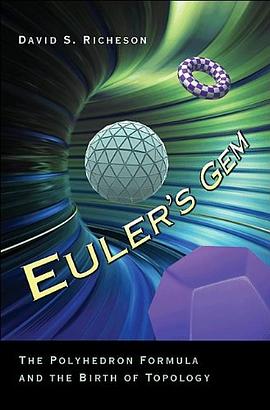Euler's Gem
内容简介
Leonhard Euler's polyhedron formula describes the structure of many objects - from soccer balls and gemstones to Buckminster Fuller's buildings and giant all-carbon molecules. Yet Euler's formula is so simple it can be explained to a child. "Euler's Gem" tells the illuminating story of this indispensable mathematical idea. From ancient Greek geometry to today's cutting-edge research, "Euler's Gem" celebrates the discovery of Euler's beloved polyhedron formula and its far-reaching impact on topology, the study of shapes. In 1750, Euler observed that any polyhedron composed of V vertices, E edges, and F faces satisfies the equation V-E+F=2.David Richeson tells how the Greeks missed the formula entirely; how Descartes almost discovered it but fell short; how nineteenth-century mathematicians widened the formula's scope in ways that Euler never envisioned by adapting it for use with doughnut shapes, smooth surfaces, and higher dimensional shapes; and, how twentieth-century mathematicians discovered that every shape has its own Euler's formula. Using wonderful examples and numerous illustrations, Richeson presents the formula's many elegant and unexpected applications, such as showing why there is always some windless spot on earth, how to measure the acreage of a tree farm by counting trees, and how many crayons are needed to color any map. Filled with a who's who of brilliant mathematicians who questioned, refined, and contributed to a remarkable theorem's development, "Euler's Gem" will fascinate every mathematics enthusiast.
......(更多)
作者简介
......(更多)
目录
Preface ix
Introduction 1
Chapter 1: Leonhard Euler and His Three “Great” Friends 10
Chapter 2: What Is a Polyhedron? 27
Chapter 3: The Five Perfect Bodies 31
Chapter 4: The Pythagorean Brotherhood and Plato’s Atomic Theory 36
Chapter 5: Euclid and His Elements 44
Chapter 6: Kepler’s Polyhedral Universe 51
Chapter 7: Euler’s Gem 63
Chapter 8: Platonic Solids, Golf Balls, Fullerenes, and Geodesic Domes 75
Chapter 9: Scooped by Descartes? 81
Chapter 10: Legendre Gets It Right 87
Chapter 11: A Stroll through Königsberg 100
Chapter 12: Cauchy’s Flattened Polyhedra 112
Chapter 13: Planar Graphs, Geoboards, and Brussels Sprouts 119
Chapter 14: It’s a Colorful World 130
Chapter 15: New Problems and New Proofs 145
Chapter 16: Rubber Sheets, Hollow Doughnuts, and Crazy Bottles 156
Chapter 17: Are They the Same, or Are They Different? 173
Chapter 18: A Knotty Problem 186
Chapter 19: Combing the Hair on a Coconut 202
Chapter 20: When Topology Controls Geometry 219
Chapter 21: The Topology of Curvy Surfaces 231
Chapter 22: Navigating in n Dimensions 241
Chapter 23: Henri Poincaré and the Ascendance of Topology 253
Epilogue The Million-Dollar Question 265
Acknowledgements 271
Appendix A Build Your Own Polyhedra and Surfaces 273
Appendix B Recommended Readings 283
Notes 287
References 295
Illustration Credits 309
Index 311
......(更多)
读书文摘
欧拉在这封信中借用了莱布尼茨创造的术语geometriam situs,意思是位置几何学。这个术语后来变成了位置分析学,最终又变成了拓扑学。莱布尼茨指的是一个新数学领域,它“直接与位置打交道,就像代数与量打交道那样”。关于欧拉是否误解了菜布尼茨的术语,学者们意见不一;尽管如此,欧拉确实认同菜布尼茨的想法,觉得需要一种新的数学技巧来处理七桥问题。
......(更多)






